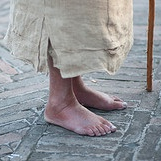
Monday I wrote about pilgrimages and the pitfall of becoming a pilgrimage junkie. The reality is that most of us are or have been, at one point or another, junkies. We depend on something or someone to bring us happiness and peace. The joy and relief we receive from our pilgrimage highs last for a few days or even weeks but eventually they fade. As they fade, we begin to either seek out our next pilgrimage or we drift along aimlessly for a while. What can we do to change this? Should we avoid pilgrimages altogether? If pilgrimages aren’t the answer to our need for change, what is?
First we need to realize that there are three paths of pilgrimage and all are helpful. The first path is the one I wrote about Monday: We run from place to place, event to event, teacher to teacher hoping all the way to catch a brief respite, a glimpse of peace. The second path looks very much like the first as we flit from place to place, event to event and teacher to teacher. The difference is that we actually take something away from our journeys and begin to use it for ourselves.
Think back to the last pilgrimage you made, whatever shape it was.  Did you return home with something that you now use to keep the spirit of that event alive? Did you learn or were you just entertained? Learning, experiencing and continuing to practice what you experienced is the journey of the second path. Simply ask yourself, “What can I take home and use in my own practice?” and then use it. This applies to pilgrimages that require you to travel far across the globe as well as those that happen in the yoga studio or Sunday School class.
Did you return home with something that you now use to keep the spirit of that event alive? Did you learn or were you just entertained? Learning, experiencing and continuing to practice what you experienced is the journey of the second path. Simply ask yourself, “What can I take home and use in my own practice?” and then use it. This applies to pilgrimages that require you to travel far across the globe as well as those that happen in the yoga studio or Sunday School class.
The third path is often the most difficult simply because it is quite impossible to see and because there is nothing to do, this is the pilgrimage inward. While there are many outward pilgrimages, there is truly only one inward pilgrimage. The inward pilgrimage is that of feeling and this is what all those outward pilgrimages are pointing toward. Happiness and peace cannot be handed out on a plate, they cannot be given in any form, they can only be felt and their wellspring is inside.
Notice what you feel right now. Now, sit quietly for ten minutes, let your eyes close and your thoughts be still. Focus on breath, feel it move. Every time any distraction comes up, focus on breath. After ten minutes, notice what you feel. As you practice postures, feel each movement and make each transition deliberately. Make every moment—driving, eating, working, playing, I mean every moment—make it part of your inward pilgrimage, notice what you feel and life will become one continuous moment of meditation.
The greatest pilgrimage you will ever make is inward to the temple of your heart.
Jai Bhagwan
“Meditation is the language of the soul.” The Prophet David O. McKay
“In prayer one talks to God. In meditation one listens.” Gurudev, Yogi Amrit Desai
